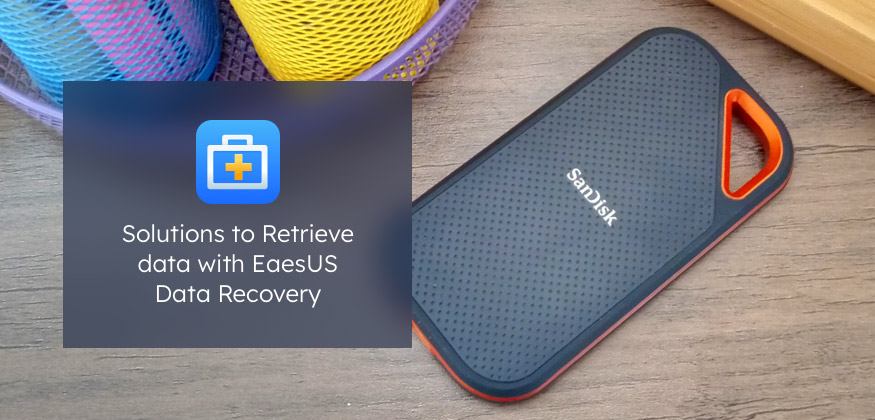
I claim a EaseUS Data Recovery Pro License Free.
mail to [email protected]
If the issue persists, contact our experts for manual service.
Users of 2 TB and 4 TB SanDisk Extreme and SanDisk Extreme Pro Portable SSDs have raised concerns regarding unexpected data loss. This issue appears specific to units manufactured in 2023, with the 4 TB external SSDs experiencing the highest problems.
Let's take a closer look at the timeline of events
-
![]()
Some Reddit threads have the discussion of Sandisk Portable SSD discussion.
Learn More >2023.5 -
![]()
At the same time, Tom's hardware is also concerned about this information, following up on the report.
Learn More >2023.5 -
![]()
EaseUS expressed immediate concern about this issue and promptly contacted Sandisk officials (unfortunately, we did not receive a response). Simultaneously, we distributed our EaseUS Data Recovery Pro version for free to Sandisk issue users.
2023.5 -
![]()
Ars senior editor Lee Hutchinson and The Verge staff Vjeran complaints surfaced about SanDisk Extreme SSDs unexpectedly wiping data and becoming unmountable. The Verge was particularly critical of the company's lack of a clear response or solution to the ongoing problems. On the other hand, SanDisk promised a software upgrade to rectify the issue, though no specific timeline was provided, leaving users in a state of limbo.
Learn More >2023.8 -
![]()
SanDisk Portable SSDs Are Failing So Frequently, Petapixel can no longer recommend them.
Learn More >2023.8
-
![]()
Arstechnica reported Sandisk users to complain and share Sandisk Official solution: will publish a firmware update.
Learn More >2023.5 -
![]()
The verge shares the news and reminds users to stay vigilant and take necessary precautions to safeguard their data.
Learn More >2023.5 -
![]()
Sandisk Release official announcement: We have identified a firmware issue that can cause SanDisk Extreme Portable SSD V2, SanDisk Extreme Pro Portable SSD V2, and WD My Passport SSD products to disconnect from a computer unexpectedly.
Learn More >2023.6 -
![]()
Three cases were filed against Western Digital seeking class-action certification due to a common defect in the firmware consistent across all devices. Lawyer Ian Sloss, representing two complainants, stated that such defect cases are "ripe for class treatment."
Learn More >2023.8
Which SSDs are affected?
SanDisk Extreme Portable 4TB (SDSSDE61-4T00)
SanDisk Extreme Pro Portable 4TB (SDSSDE81-4T00)
SanDisk Extreme Pro Portable 2TB (SDSSDE81-2T00)
SanDisk Extreme Pro Portable 1TB (SDSSDE81-1T00)
Western Digital My Passport 4TB (WDBAGF0040BGY).
Can I Recover My Precious Data in these Portable SSD? Software & Service
In this situation, a professional recovery company could retrieve the lost data using tools or manual services, but it will likely be costly. To help those affected, EaseUS is offering free licenses to SanDisk users as a lifeline for those struggling with data loss due to SSD failures. If you use SanDisk, please refer to the following guide for further help.

EaseUS Giveaway:
1. EaseUS would like to offer people with broken SanDisk Extreme Portable SSD a license key to the Pro version of EaseUS Data Recovery Wizard to try their luck in the cases where data recovery software can help.
2. EaseUS would like to offer EaseUS Todo Backup Home (Windows version) for free to protect your data on SanDisk Extreme SSDs before updating the firmware, as Western Digital suggested.
How to get the license?
Just email [email protected] with the title of Sandisk Extreme SSD Data Recovery Help Needed. And offer the following information to make we better know this event and offer more accurate help:
1, your SSD type;
2, the time you bought the SSD
3, the problem your SanDisk SSD caused to you
4, Your OS- Mac or Windows - this will decide the license key version, Windows or Mac version
If you find this helpful, please feel free to let more of your family or friends know about this campaign by sharing this page.
If you're interested in learning more about the event, feel free to check out our Twitter feed!
😨Facing issues with your #SanDisk Extreme SSDs?@EaseUS_software is here to help!
— EaseUS (@easeus_software) September 12, 2023
😍We're giving away #EaseUSDataRecoveryWizard Pro for SanDisk Extreme Pro Portable SSD failures caused data loss.
🎁Follow & RT & Comment on this post to get the license. Check pic for details. pic.twitter.com/bkKUV2uaIi
Solutions to Retrieve data with EaseUS Data Recovery:
- 1: Download EaseUS Data Recovery Wizard
- 2: Select the location containing lost data
- 3: Select Quick File Search or Full Scan.
- 4: Choose the relevant file or folder.
- 5: Select the file from the list on the right.
- 6: Click … to select the output folder for recoverable files
EaseUS Data Recovery Wizard
- 17 Years of Professional Data Recovery Experience

EaseUS is a leading software company specializing in data backup, recovery, and disk management. Founded in 2004, the company aims to provide users with secure, reliable, and comprehensive solutions to data troubles such as data loss or disk organization. EaseUS's software is trusted by millions of users worldwide, and it provides solutions for both individual users and businesses. They are committed to continuous research and development to provide innovative and effective solutions. Their expertise also extends to offering guidance on how to solve common tech problems, like the SanDisk Extreme Pro Portable SSD not working.
As for the next steps, users are advised to wait for SanDisk's official solution while also being encouraged to share the EaseUS assistant with other users who may be in need. In this time of uncertainty, it's crucial for the community to come together and share resources to mitigate the impact of the SanDisk SSD issue
The unfolding saga of SanDisk's SSD failures serves as a stark reminder of the importance of reliable hardware and the power of community support. It's hoped that SanDisk will soon provide a solution to restore users' faith in their products.







